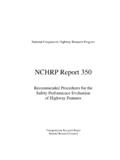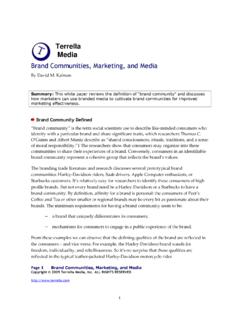Transcription of Motorcycle Oil Comparison - oil-tech.com
1 AMSOIL Power Sports Group June 2009, AMSOIL Study ofMotorcycleOilsSecond EditionMotorcycle Oil Comparison2 Table of Properties, Performance Results and Viscosity Grade (Initial Viscosity - SAE J300)..6 Viscosity Index (ASTM D-2270)..8 Viscosity Shear Stability (ASTM D-6278)..9 High Temperature/High Shear Viscosity (HT/HS ASTM D-5481)..11 Zinc Concentration (ppm, ICP)..12 Wear Protection (4-Ball, ASTM D-4172)..13 Gear Performance (FZG ASTM D-5182)..14 Oxidation Stability (TFOUT ASTM D-4742)..16 Volatility (Evaporation) (ASTM D-5800)..17 Acid Neutralization and Engine Cleanliness (TBN ASTM D-2896)..18 Foaming Tendency (ASTM D-892)..19 Rust Protection (Humidity Cabinet ASTM D-1748).. Compatibility (JASO T 904:2006, limited review)..22 Scoring and Summary of of Test s Note:At the time of its original printing in December 2005, the A Study of Motorcycle Oilswhite paper representedthe most comprehensive study of Motorcycle oils ever published.
2 The document served to educate hundreds of thousands ofreaders on the complex dynamic of Motorcycle oil and Motorcycle operation. The paper revealed, through an exhaustive seriesof relevant industry tests, that the Motorcycle oils available to consumers varied greatly in quality and in their ability to performthe functions of Motorcycle second edition printing maintains the same scientific approach and includes the same testing protocol. Additional oilswere tested, and some of the original oils tested differently than they had initially, indicating formulation changes. It shouldbe noted that the products appearing in this study were those formulations available in the marketplace at the time the testing was performed. AMSOIL recognizes that manufacturers change formulas from time to time, and some of theproducts in this report may have since been reformulated.
3 OverviewMotorcycles have long been used as a popular means of general transportation as well as for recreational use. There arenearly seven million registered motorcycles in the United States, with annual sales in excess of one million units. This trendis unlikely to change. As with any vehicle equipped with an internal combustion engine, proper lubrication is essential toinsure performance and longevity. It is important to point out that not all internal combustion engines are similarly designedor exposed to the same types of operation. These variations in design and operation place different demands on engineoils. Specifically, the demands placed on Motorcycle engine oils are more severe than those placed on automotive engineoils. Therefore, the performance requirements of Motorcycle oils are more demanding as the degree may be debatable, few will disagree that a difference exists between automotive and Motorcycle appli-cations.
4 In which area these differences are and to what degree they alter lubrication requirements are not clear to mostmotorcycle operators. By comparing some basic equipment information, one can better understand the differences that following Comparison information offers a general synopsis of both automotive and Motorcycle Max. HP@ HP cu. , engine cu. , engine RamL/D TruckWater345 cu. , engine cu. , engine CBRM otorcycleWater61 cu. - engine RRPerformancecooledtr ansmissionBMW RMotorcycleAir & cu. - RTTouringcooled& transmissionH/D RoadMotorcycleAir cooled88 cu. - Bore& cu. , engine ansmissionThere are six primary differences between Motorcycle and automotive engine applications:1. Operational Speed - motorcycles tend to operate at engine speeds significantly higher than automobiles.
5 Thisplaces additional stress on engine components, increasing the need for wear protection. It also subjects lubricatingoils to higher loading and shear forces. Elevated operating RPMs also promote foaming, which can reduce an oil sload-carrying ability and accelerate Compression Ratios - motorcycles tend to operate with higher engine compression ratios than compression ratios place additional stress on engine components and increase engine operating tempera-tures. Higher demands are placed on the oil to reduce wear. Elevated operating temperatures also promote thermaldegradation of the oil, reducing its life expectancy and increasing the formation of internal engine Horsepower/ Displacement Density - Motorcycle engines produce nearly twice the horsepower per cubic inchof displacement of automobile engines.
6 This exposes the lubricating oil to higher temperatures and Variable Engine Cooling - In general, automotive applications use a sophisticated water-cooling system to con- trol engine operating temperature. Similar systems can be found in Motorcycle applications, but other designs alsoexist. Many motorcycles are air-cooled or use a combination air/oil design. Though effective, they result in greater fluc-tuations in operating temperatures, particularly when motorcycles are operated in stop-and-go traffic. Elevated oper-ating temperature promotes oxidation and causes oils to thin, reducing their load carrying Multiple Lubrication Functionality - In automotive applications, engine oils are required to lubricate only theengine. Other automotive assemblies, such as transmissions, have separate fluid reservoirs that contain a lubricantdesigned specifically for that component.
7 The requirements of that fluid differ significantly from those of automotiveengine oil. Many motorcycles have a common sump supplying oil to both the engine and transmission. In such cases,the oil is required to meet the needs of both the engine and the transmission gears. Many motorcycles also incorpo-rate a frictional clutch within the transmission that uses the same Inactivity - motorcycles are typically used less frequently than automobiles. Whereas automobiles are used on adaily basis, Motorcycle use is usually periodic and in many cases seasonal. These extended periods of inactivity placeadditional stress on Motorcycle oils. In these circumstances, rust and acid corrosion protection are of critical is apparent that Motorcycle applications place a different set of requirements on lubricating oils.
8 Motorcycle oils, there-fore, must be formulated to address this unique set of high stress purpose of this paper is to provide information regarding Motorcycle applications, their lubrication needs and typicallubricants available to the end user. It is intended to assist the end user in making an educated decision as to the lubricantmost suitable for his or her Motorcycle testing used to evaluate the lubricants was done in accordance with American Society for Testing and Materials (ASTM)procedures. Testing was finalized in May 2009. Test methodology has been indicated for all data points, allowing for dupli-cation and verification by any analytical laboratory capable of conducting the ASTM tests. A notarized affidavit certifyingcompliance with ASTM methodology and the accuracy of the test results is included in the appendix of this document.
9 Fivedifferent laboratories were used in the generation of data listed within this document. In all cases blind samples were sub-mitted to reduce the potential of document reviews the physical properties and performance of a number of generally available Motorcycle oils. Thoseareas of review are:1. An oil s ability to meet the required viscosity grade of an An oil s ability to maintain a constant viscosity when exposed to changes in An oil s ability to retain its viscosity during An oil s ability to resist shearing forces and maintain its viscosity at elevated An oil s zinc An oil s ability to minimize general An oil s ability to minimize gear An oil s ability to minimize deterioration when exposed to elevated An oil s ability to resist volatilization when exposed to elevated An oil s ability to maintain engine cleanliness and control acid An oil s ability to resist An oil s ability to control rust results have been listed for each category.
10 The results were then combined to provide an overall picture of theability of each oil to address the many demands required of Motorcycle CandidatesTwo groups of candidate oils were tested, SAE 40 grade oils and SAE 50 grade oils. The oils tested are recommendedspecifically for Motorcycle applications by their GradeBaseBatch NumberAMSOIL MCF10W-40 Synthetic11631 231 Bel-Ray EXS Super Bike0W-40 SyntheticAF 25940607 Castrol Power RS R4 4T5W-40 Synthetic 14/02/28/C7011996 Honda HP410W-40 Syn / Petro Blend7 KJA0001 Lucas High Performance10W-40 Syn / Petro BlendNone indicated on containerMaxima Maxum 4 Ultra5W-40 Synthetic1608 Mobil 1 Racing 4T10W-40 SyntheticX10C8 4967 Motul 300V Factory Line10W-40 Synthetic04611/03235M1 Pennzoil Motorcycle Oil10W-40 PetroleumHLPA418968/04237 21.


